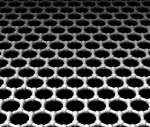University of Southern California researchers have created flexible transparent carbon atom films they say have great potential for a new breed of solar cells.
The team’s unique approach to organic photovoltaic [OPV] cell design has significant advantages, especially in the area of physical flexibility. Graphene, a highly conductive and transparent form of carbon made up of atoms-thick sheets shows good potential to fill this role.
The USC engineering team creates ultra-thin graphene sheets by first depositing carbon atoms in the form of graphene films on a nickel plate from methane gas. A protective layer of thermo plastic over the graphene layer is laid down and then the underlying nickel is dissolved in an acid bath. Finally, the plastic-protected graphene is attached to a very flexible polymer sheet, which can be incorporated into a OPV cell.
Graphene/polymer sheets ranging in sizes up to 150 square centimetres have been produced using this method.
These OPV devices aren’t as efficient as silicon solar cells; creating just 14 watts of electricity for every 1,000 watts of sunlight. However, what these graphene OPV cells lose in efficiency is made up for in lower price and flexibility. Like some other new solar cell technology, this OPV design may lend itself to being mass produced via a form of printing press.
"They could be hung as curtains in homes or even made into fabric and be worn as power-generating clothing. I can imagine people powering their cellular phone or music/video device while jogging in the sun," says Lewis Gomez De Arco, a doctoral student and a member of the team that built the graphene OPVs.
The USC researchers say graphene OPVs show some advantages over Indium-Tin-Oxide (ITO) OPV design. While ITO cells fail at a very small angle of bending, the graphene-based cells remained operational after repeated bending at much larger stress angles.
Source












































